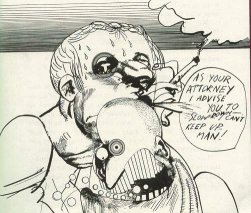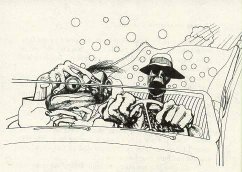The Music of Fear and Loathing
A Rant Under the Pretext of Being a Review
By: Danielle Woodrich

 For Thompson purists who contemplated not buying this soundtrack, let me reassure you that like the script, the soundtrack closely follows the dictates of text from the 1971 Hunter S. Thompson novel, Fear and Loathing in Las Vegas.
For Thompson purists who contemplated not buying this soundtrack, let me reassure you that like the script, the soundtrack closely follows the dictates of text from the 1971 Hunter S. Thompson novel, Fear and Loathing in Las Vegas.Films whose stories take place in the 1970's are like parties with a guest who gets too wasted and makes everyone laugh hardest when his one-liners are self-scathing ones. You know the type; you might even be the type. At Terry Gilliam's shockingly non-interpretive party, Fear and Loathing in Las Vegas, that guest is not writer Raoul Duke - the main character (played by Johnny Depp). Nor is the tragedian partier Duke's eye-popping weekend companion, the unbalanced "Attorney" (Benicio Del Toro). The jester of Gilliam's bash is Music. And this particular Music is only two cocktails and a whiff of something noxious from falling to lamenting pieces at It's own humor.
The voices of Big Brother and the Holding Company (Janis Joplin and Sam Houston Andrews) ripping out "Combination of the Two" begin the disk released by Geffen Records. Was "Don't matter who you are, no, don't matter where you came from. You just gotta try to feel it, C'mon, C'mon, C'mon, C'mon. C'mon," the hi-fi call to arms for the real-life author Hunter Thompson and L.A. attorney Oscar Acosta? Maybe. It does seem that their partnership, in the adventure of searching for the rotting heart of the American Dream, stripped them down to the ultimate raw. The pair fired off not-quite-metaphorical sniper fire at those suspected of harboring the Dream out of their sight and reach. They were two combustible elements, hissing and smoking towards the inevitable explosion. This violence united Thompson and Acosta in the gamy foxhole they dug with rusty compulsive spoons and bent-back fingernails. They were not particularly proud of it, but as long as they had Randian self-worth, sufficient credit, music, drugs, and time, they could live in that hole. Until Acosta's disappearance in 1974, he did. Hunter did, too, and if you ever heard the words "Woody Creek" or "Owl Farm," you know he still does.
 At the time, the country was, after all, still in Vietnam when both the Mint 400 article and the Rolling Stone magazine serialization of Fear and Loathing appeared. Thompson was not new to the idea that people cannot stop war with love or reason. He knew in 1971, as some of us know now: wars end only when the warring is done and sometimes not even then. The songs in the film that bend political only do so subtly, and not without irony, like The Youngbloods' gentle anthem "Get Together," during a depressed rant of Thompson's while he, in the form of Depp, views heinous news footage of the war on a bank of stolen television sets in Dementia Uber Alles Headquarters at the Circus Circus. "Come on people now, smile on your brother!"
At the time, the country was, after all, still in Vietnam when both the Mint 400 article and the Rolling Stone magazine serialization of Fear and Loathing appeared. Thompson was not new to the idea that people cannot stop war with love or reason. He knew in 1971, as some of us know now: wars end only when the warring is done and sometimes not even then. The songs in the film that bend political only do so subtly, and not without irony, like The Youngbloods' gentle anthem "Get Together," during a depressed rant of Thompson's while he, in the form of Depp, views heinous news footage of the war on a bank of stolen television sets in Dementia Uber Alles Headquarters at the Circus Circus. "Come on people now, smile on your brother!"
But anyway, it wasn't so much about politics then. That addiction would sink its fangs into the jugular of Thompson's muse soon enough.
Make no mistake: in Fear and Loathing in Las Vegas, it was about drugs.
No matter how many ticketstub-credentialed I-Was-THERE-Man-It-Was-UNIQUELY-Fucked-Up-and-Sublime experts of the time say to the contrary, I am doing you a brutal favor by telling you the truth. The truth is - drugs have always fit decrepitly heroic rock music of each of the past 4 or 5 decades like a three-button shark skin suit. It works like lounge tunes, bourbon and broads. In other words, it is the timeless fashion of fiends, this Art of distortions, frightening, personal, and beautiful.
In those early years for Thompson there were many rocking drug tunes to morph with Gilliam's modern visual direction. "One Toke Over the Line" and "White Rabbit, by Brewer/Shipley and Jefferson Airplane respectively, always somewhat ridiculous songs, in the film become lavishly hilarious Jester appearances, one shining, smiling, the other sinister and snickering, compliments of a screen-filling Benicio Del Toro.
To slide in amongst the laughs Three Dog Night's "Mama Told Me Not to Come, " and the Yardbirds' crude but still carrying "For Your Love" was a great move. They provide musical flesh to the past-peering fantasy. The song whose lyrics run throughout both the novel and the film, "Stuck Inside of Mobile with the Memphis Blues Again", by Bob Dylan, is also well chosen and placed on the Geffen disk. These songs seem to compulsively vacation in the before-sleep repetitive groove in one's mind. Most importantly, they are consistent with the theme that getting weird is the way to go, until suddenly, all too clearly, it's not.
The Cheese Spread Trilogy includes Tom Jones' pure Velveeta "She's a Lady," the far too fat-free (not to mention toxically saccharined) "Tammy" sung all carnation pink and breathy by Debbie Reynolds, and "Magic Moments," by plastic-wrapped square Perry Como.
Not to be truly included in the Cheese Trilogy (which would then no longer be a trilogy - Doh!) yet impossible to exclude entirely is the supremely executed Dead Kennedy's version of the Elvis classic "Viva Las Vegas."
Booker T and the MG's roll easily through "Time is Tight." "Expecting to Fly", written by Neil Young and performed by Buffalo Springfield, round out the disk. The one song sorely missed and much referred to in the novel is "Sympathy for the Devil" by the Rolling Stones. After all the media on the "Bittersweet Symphony" rights, I suspect it was more trouble than it was worth. It played in my head anyway, costing exactly Zero in royalties.
The Trip Trilogy is the three tracks created exclusively for the film by the disk's producer, Ray Cooper, and Japanese rock guitarist, Tomoyasu Hotei. One of the disturbing and wonderful arrangements accompanies the pristinely word-for-word narrative that contains the famous verse-like excerpt "...with the right kind of eyes you can almost see the high-water mark--that place where the wave finally broke and rolled back." Then there is the soundscape for the Adrenochrome scene, and "You took too much, Man....too much, too much! Jesus, that shit got right on top of you, didn't it?" The third mood in the drug swing is a creeped out ambient bit of oddness and strangled mono, not stereo, riffs of Jimi Hendrix. The sounds enhance the prose of the "buy the ticket take the ride" criticism of the illusory lifestyle and hubris of the acid culture.
 Between every song are snippets of dialogue and Depp-read paragraphical musings straight from Thompson's twisting brain. They touch on a multitude of chemical consumptive mini-plots that I must have been too high at the viewing to be able to recall now. I was probably sneaking a bat-hit and a gulp of Wild Turkey under my movie theater seat. You know, I hear "you can actually watch yourself behaving in this terrible way, but you can't control it."
Between every song are snippets of dialogue and Depp-read paragraphical musings straight from Thompson's twisting brain. They touch on a multitude of chemical consumptive mini-plots that I must have been too high at the viewing to be able to recall now. I was probably sneaking a bat-hit and a gulp of Wild Turkey under my movie theater seat. You know, I hear "you can actually watch yourself behaving in this terrible way, but you can't control it."
The point is, my friends, with the right kind of ears, you can almost hear the crash of the wave as, after barreling wildly down the hallway of mainstream-America, it struck rock as solid as the Sixties' faith in nothing. It broke like particleboard smashed over the heads of everyone not On the Bus, and rolled back down to the floor in a scummy disease-addled pool, hung over, spent, whimpering and cursing, but still alive.
"So much, then, for The Road - and for the last possibilities of running amok in Las Vegas & living to tell the tale. But maybe we won't really miss it. It was a good way to go, and I recommend it highly - at least for those who can stand the trip. And for those who can't, or won't, there is not much else to say. Not now, and certainly not by me!"

